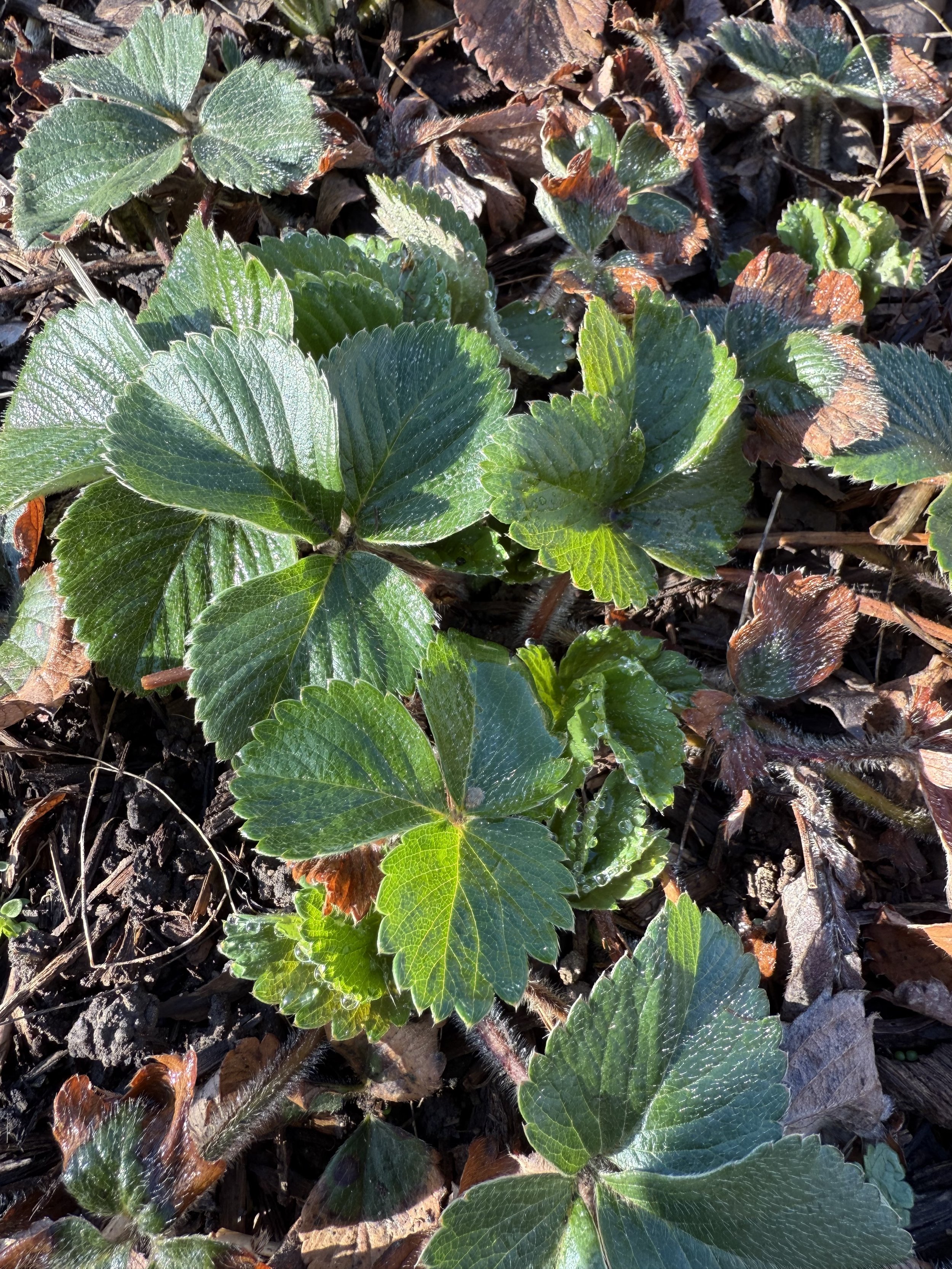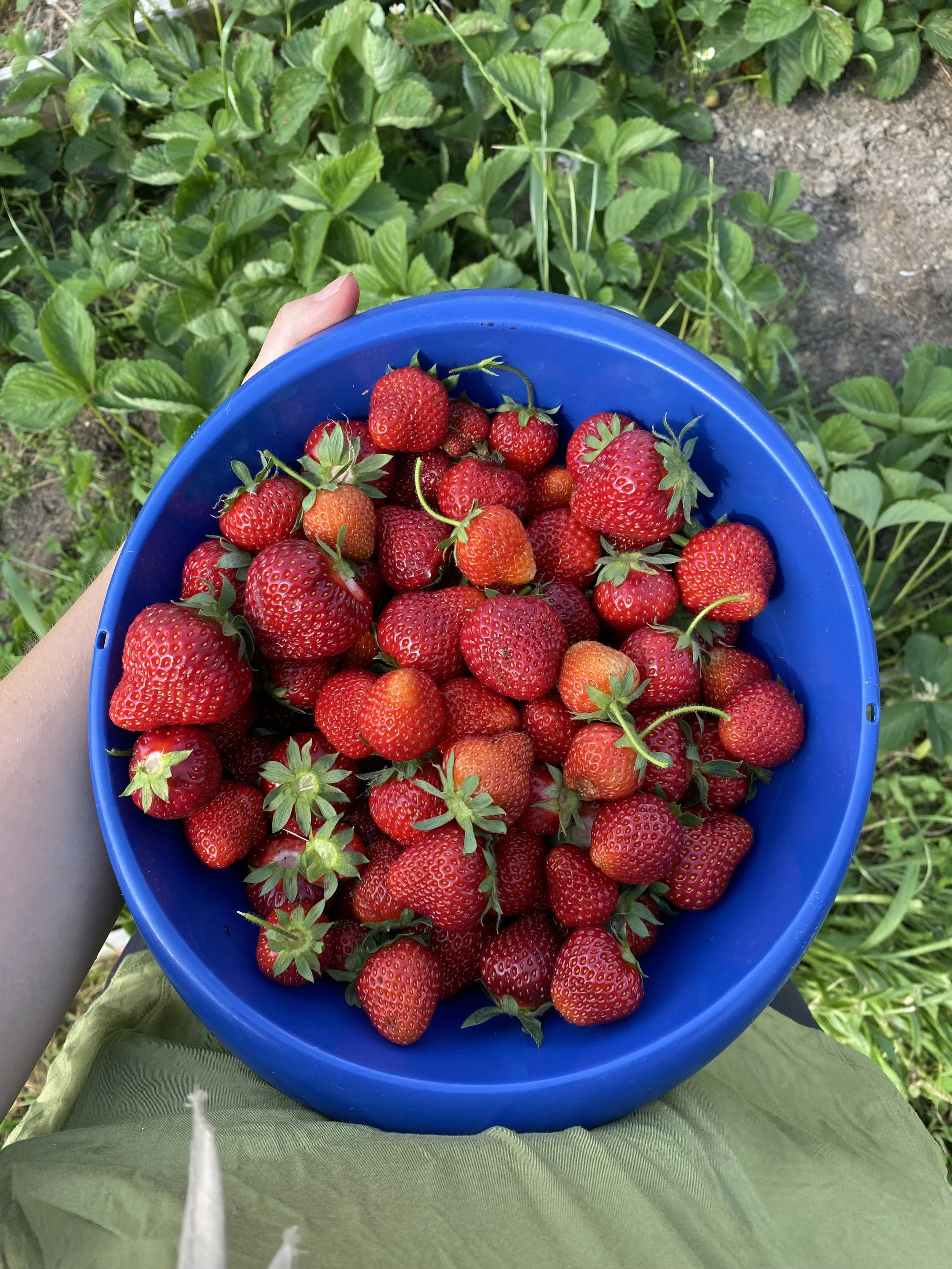A Berry Bare-Root Bounty: Growing a Strawberry Patch
By - Emma Rauschert, University of Illinois Extension Master Gardener and Master Naturalist
Strawberries are one of my all-time favorite fruits on the homestead. They are easy to establish and maintain and produce a bounty. Don't get me started on their superior taste compared to store-bought. A red, juicy strawberry freshly plucked from the garden after basking in the sun all day is like eating something from another planet.
Kinds of Strawberry Plants
You can order bare-root strawberries online, buy from a local nursery if they have them, or ask a friend with a patch if you can dig up some starts. There are many different strawberry varieties: June-bearing, ever-bearing, and day-neutral. June-bearing strawberries produce large berries a few weeks in the summer, and that's it for the year, but goodness, are they big and juicy. Some popular June-bearing varieties are Earliglow, Honeoye, and Jewel. Ever-bearing plants produce a smaller crop typically twice a season, in early summer and again in the fall. A popular variety of ever-bearing is Ft. Laramie. Day-neutral berries produce continually throughout the summer and are considered the most improved varieties for production. These berry varieties include Albion, San Andreas, and Tristar.
What is a Bare-Root Plant?
A bare root is exactly what it sounds like: a bare root. This plant is dormant, and its foliage has not yet grown, so it is only a bundle of roots. When bare-root plants arrive in the mail, the roots will all be clustered together, and you will have to separate the bunches. One advantage of bare root plants is that they are usually a fraction of the cost of store-bought pre-potted plants. They can also be planted in early spring before the rest of your garden needs immediate attention. The window for planting bare roots is when the ground has thawed and can be worked, but before the spring growth has begun. Early April in our region, or even a couple of weeks before, is a perfect time. When the trees start leafing out, so will your bare-root plants.
Preparing the Planting Site
To locate a perfect place for your strawberry patch, think of an area that has full sun (at least 6 hours a day), well-drained soil (not a low spot that puddles a lot), and a location away from a lot of traffic, such as dogs, tractors, or scratching chickens. Strawberries can make excellent ground covers in a landscaping bed. Do not plant where tomatoes, potatoes, or peppers have been planted in the past, as the soil could hold verticillium wilt, which could harm your strawberries later on. Clear the area of weeds or grass by tarping, tilling, or removing the sod manually. If you want to grow fat, delicious berries, bring in some compost and mix it in with the top layer of soil.
Different Kinds of Planting Methods
There are a few different planting methods to aid in the success of your strawberry patch. Strawberries can be grown on hills or in rows. One bare-root strawberry plant will send out "daughter plants" or runners. These runners will spread out from the mother plant and create new baby plants. These methods promote bigger berries, less disease, and a more orderly patch.
Matted Row Method: Space each strawberry plant out at least 18 inches from another plant in a row and plant the rows 4 feet apart. This gives the strawberry and future runners plenty of space to thrive. This method is commonly used when planting June-bearing strawberries.
Hill Method: You may want to train your strawberries to grow a certain way, such as the hill method, where you remove the daughter runner plants so only the mother grows. The mother plant stops putting energy into runners and puts all of her energy into growing numerous crowns and flower shoots. The hill method is best for ever-bearing and day-neutral varieties.
Spaced-Row Method: You can train the daughters' runners to grow only vertically in rows by removing the horizontal runners. This method is called the spaced-row method.
Planting Instructions
Bare roots should be kept in a cool area until planted to maintain their dormancy. If their planting must be prolonged, the roots must be wrapped in a moist paper towel or rag and stored in a fridge. To plant, dig a hole that is a little larger than the plant's roots. Place the roots in the hole. The roots should be spread out as best as possible and remain spread out while being covered with soil. Fill the hole with dirt, but be careful not to cover the plant's crown. The crown is where the roots meet the sprouting foliage and is thicker. The plant can rot if soil covers the crown or is too close to the crown. I like holding the base of the crown slightly above the soil line to avoid such a catastrophe. After planting berries, water them in, or time your planting right before a good spring rain shower. Water your strawberries at least an inch per week, and if you plant early in the spring, it will rain enough that you may not have to water very much.
Maintaining the Patch
The hardest part of growing strawberries is picking the blossoms off the first year. That's right, you shouldn't let the strawberries you just planted grow berries. The purpose of stopping them from producing berries is that they will send more energy into their roots to get established. Blossoms in July can be left to grow into berries.
Keep the weeds under control. The best way to do this is by properly preparing the site by clearing all vegetation before planting and adding compost. If you do have weeds, don't let them take over. Keep an eye on your patch in the first few weeks and pull out any weeds you spot. You can also mulch lightly around your strawberry plants with straw or sawdust to keep weeds down. Straw should also be added around the patch before winter to keep the plants insulated and help regulate soil temperature. In the spring, remove the straw from the strawberry plants and put it between the rows to keep weeds down.
Enjoy your new berry patch and all the delicious things you can make with your berries. I hope this article convinced you to grow some strawberries. What do you have to lose? Time? You're losing that anyway. Now get out there and get growing.


